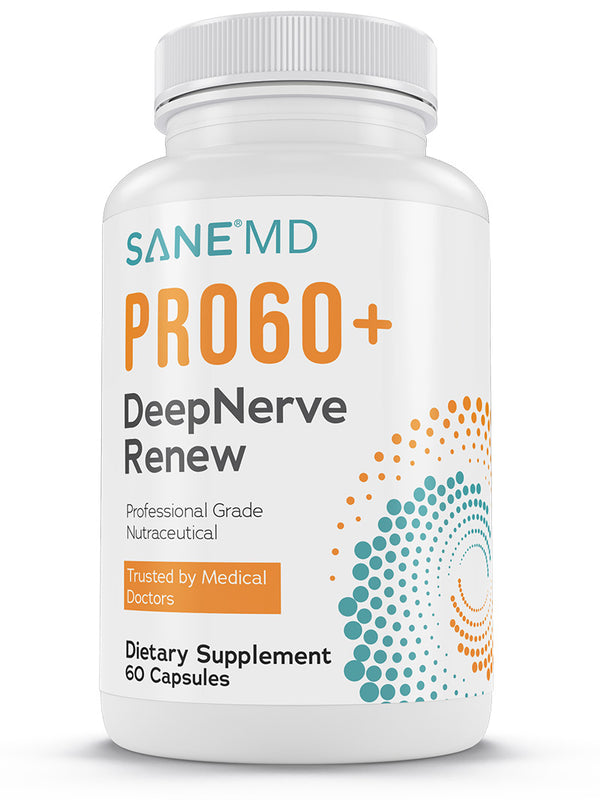Craving food? It’s not in your stomach, but in your brain! New research shows a shocking link between chronic brain inflammation and food cravings, which is a type of brain inflammation. Imagine being able to shut off that inner voice for craved foods like sweets or salty snacks by shutting off your brain. This could change everything we thought we knew about dieting and weight loss.
Click here to learn more about Vitaae and to place your order now while supplies last!
While brain inflammation is most commonly associated with traumatic brain injury or neurodegenerative diseases like Alzheimer’s and other central nervous system impairments, chronic brain inflammation is caused by a leaky blood-brain barrier from lifestyle and dietary habits and can be fixed. Eating unhealthy foods damages the blood-brain barrier over time. It allows foreign substances to seep into the brain regions and activate the microglia, the brain’s immune cells, leading to activated microglia, which contribute to neuroinflammation.
Chronic brain inflammation—a silent problem often undetected because the symptoms are subtle—can be the saboteur of our diets. But don’t worry; for every problem, there’s a solution. In this case, nature has given us plenty of solutions to brain inflammation and food cravings.
Let’s get into this and look at how we can calm our brains and control our food desires. From the food we eat to the life we live, small changes can make a big difference. This isn’t just about weight loss or overcoming cravings; it’s about getting to a healthier life.
By using these strategies, we can take control of our health and make informed decisions for our brain and, therefore, our whole body. So, let's explore these natural remedies and lifestyle changes and see how they can calm our brains, quiet our cravings and boost our health.
And remember, knowledge shared is power multiplied. If you find this helpful, don’t keep it to yourself. Share it with friends, family, or anyone you think could benefit from a new way of thinking about food cravings and brain health. Together, we can create a healthier, more fulfilled community.
LIFESTYLE SHIFTS: CALMING BRAIN INFLAMMATION AND QUIETING FOOD CRAVINGS
Brain inflammation and food cravings aren’t just about what’s on our plate or physical activity. It’s about our whole daily routine. From the air we breathe to our environment, small lifestyle changes can create balance in the brain and quiet those cravings. Let’s look at four simple lifestyle changes that can make a big difference to our well-being and boost brain health and function.
1. SLEEP QUALITY
Sleep isn’t rest; it’s repair for the brain. Poor sleep can increase inflammatory cytokines and other inflammatory mediators, which contribute to brain inflammation. Consistent, high-quality sleep can reduce brain inflammation and balance hunger hormones.
Chronic sleep deprivation not only disrupts hunger hormones but also complicates the management of cravings and weight. For those facing significant weight challenges, identifying their weight loss drug type (quiz here), in consultation with a healthcare provider, may complement lifestyle changes and improve long-term results.
Create a sleep sanctuary that is free of electronic distractions and establish a pre-bedtime routine. This will calm the mind and the craving impulses so we can make better choices in the morning.
2. CLEAN LIVING SPACE
The spaces we live in impact our health. Exposure to environmental toxins can lead to systemic inflammation, which affects brain health. Reducing exposure to environmental toxins like synthetic air fresheners, household cleaners with harsh chemicals, and mold can reduce the load on our brain’s inflammatory response. Use natural cleaning products, ensure good ventilation, and introduce indoor plants to help purify the air. A clean living space benefits the brain and creates a wellness sanctuary.
MINDFUL TECHNOLOGY USE AND MINDFUL EATING
In this digital age, our brains are constantly being bombarded with information which can cause stress and inflammation. Setting boundaries around technology use, especially before bed, can help mitigate this. Excessive technology use can contribute to stress and inflammation, which are linked to mitochondrial dysfunction further impacting brain health. Take time to unplug and do activities that nourish the soul, like reading a book or spending time in nature. Mindful technology use can preserve our brain health and quiet the impulse for comfort food as a stress response.
4. BUILD SOCIAL CONNECTIONS
Human connection is a source of comfort and joy and can be a natural antidote to stress and inflammation. Engaging in meaningful relationships and community activities can boost our mood and resilience and reduce the need to eat. These connections can also reduce overall inflammation including peripheral inflammation, which benefits brain health. Whether it’s a deep conversation with a friend or community service, these connections remind us of the joys beyond the dinner table. Meaningful relationships and community activities can also boost our immune system, which further reduces brain inflammation.
By implementing these lifestyle changes, we calm brain inflammation and address the root of food cravings. This holistic approach is the path to not just better health but a more fulfilled and balanced life. Remember, the journey to wellness is a collection of small choices that, when combined, create a masterpiece of health and happiness.

The Role of Excess Weight in Brain Inflammation and Food Cravings
Excess weight and obesity don’t just impact physical health—they can also significantly affect brain function. Research shows that obesity is associated with chronic, low-grade systemic inflammation, which can cross the blood-brain barrier and lead to brain inflammation. This connection helps explain why individuals with excess weight often experience stronger food cravings and find it harder to resist certain foods.
One of the primary culprits is the release of inflammatory cytokines from adipose (fat) tissue. These molecules contribute to neuroinflammation, which can disrupt the brain's reward pathways and amplify cravings for high-calorie, processed foods. This creates a vicious cycle where food cravings lead to overeating, further weight gain, and additional inflammation, making it harder to break free from unhealthy eating patterns.
Managing Weight and Brain Health Together
Addressing obesity involves more than just weight loss; it requires a holistic approach that includes calming brain inflammation. Lifestyle changes such as adopting an anti-inflammatory diet, increasing physical activity, and practicing mindfulness are powerful tools for both managing weight and supporting brain health. Foods rich in omega-3 fatty acids, antioxidants, and fiber can help reduce systemic inflammation and stabilize blood sugar levels, curbing cravings and promoting a healthier relationship with food.
The Role of Weight Loss Drugs in Breaking the Cycle
For certain individuals struggling with significant weight challenges, weight loss drugs may provide additional support. These medications work by targeting key mechanisms such as appetite regulation or metabolic processes, helping to reduce caloric intake and support weight management. While not a standalone solution, weight loss drugs can complement other strategies to alleviate the cycle of cravings and weight gain, particularly for those with obesity-related inflammation.
A Holistic Approach to Wellness
Breaking the link between excess weight, brain inflammation, and food cravings requires a comprehensive strategy. Combining dietary changes, regular exercise, stress management, and, in some cases, weight loss medications for compatible individuals can create a sustainable path to better health. By addressing both the physical and neurological aspects of obesity, individuals can reduce inflammation, calm their brains, and achieve a more balanced and fulfilling lifestyle.
NOURISHING THE BRAIN: DIET CHANGES TO CALM INFLAMMATION AND CRAVINGS
While our lifestyle paints the picture of our health, what we eat colors our well-being. The relationship between our diet, brain inflammation, and food cravings is complex, and what we eat can fuel inflammation or starve it. Eating unhealthy foods damages the blood-brain barrier over time and allows foreign substances to seep into the brain regions and activate the microglia, the brain’s immune cells.
This section shows dietary changes to calm brain inflammation and reduce mindless snacking. Each change is a step towards a diet that nourishes the brain and aligns our cravings with our body’s needs. But remember to also practice mindful eating to get the most out of these brain-healing dietary strategies.
1. ADD OMEGA-3 FATTY ACIDS
Omega 3’s are the brain’s protectors. They can calm inflammation and balance the mood. Found in fatty fish like salmon, mackerel, and sardines, as well as flaxseeds and walnuts, these essential fats are necessary for brain function and reduce inflammation. Adding omega-3-rich foods to your diet, or taking an omega-3 fatty acid supplementdaily, can calm the brain’s inflammatory responses and quiet sugar and processed food cravings.
The Role of Excess Weight in Brain Inflammation and Food Cravings
Excess weight and obesity don’t just impact physical health—they can also significantly affect brain function. Research shows that obesity is associated with chronic, low-grade systemic inflammation, which can cross the blood-brain barrier and lead to brain inflammation. This connection helps explain why individuals with excess weight often experience stronger food cravings and find it harder to resist certain foods.
One of the primary culprits is the release of inflammatory cytokines from adipose (fat) tissue. These molecules contribute to neuroinflammation, which can disrupt the brain's reward pathways and amplify cravings for high-calorie, processed foods. This creates a vicious cycle where food cravings lead to overeating, further weight gain, and additional inflammation, making it harder to break free from unhealthy eating patterns.
Managing Weight and Brain Health Together
Addressing obesity involves more than just weight loss; it requires a holistic approach that includes calming brain inflammation. Lifestyle changes such as adopting an anti-inflammatory diet, increasing physical activity, and practicing mindfulness are powerful tools for both managing weight and supporting brain health. Foods rich in omega-3 fatty acids, antioxidants, and fiber can help reduce systemic inflammation and stabilize blood sugar levels, curbing cravings and promoting a healthier relationship with food.
The Role of Weight Loss Drugs in Breaking the Cycle
For individuals struggling with significant weight challenges, weight loss drugs may provide additional support. These medications work by targeting key mechanisms such as appetite regulation or metabolic processes, helping to reduce caloric intake and support weight management. While not a standalone solution, weight loss drugs can complement other strategies to alleviate the cycle of cravings and weight gain, particularly for those with obesity-related inflammation.
A Holistic Approach to Wellness
Breaking the link between excess weight, brain inflammation, and food cravings requires a comprehensive strategy. Combining dietary changes, regular exercise, stress management, and, in some cases, weight loss medications can create a sustainable path to better health. By addressing both the physical and neurological aspects of obesity, individuals can reduce inflammation, calm their brains, and achieve a more balanced and fulfilling lifestyle.
2. DRINK WITH PURPOSE
Water is the elixir of life and a key part of a brain-healthy diet. Chronic dehydration can exacerbate brain inflammation and disrupt the hormone balance that regulates hunger and fullness. By drinking with purpose – aiming for 8 glasses of water a day – you’re not only supporting your brain health but also reducing the likelihood of mistaking thirst for hunger.
3. EAT MORE LEAFY GREENS
Leafy green vegetables like spinach, kale, and Swiss chard are packed with vitamins, minerals and antioxidants that calm inflammation and support overall brain health. Their high fiber content also helps to stabilize blood sugar levels, which can help manage food cravings. A daily serving of leafy greens is part of a diet that supports cognitive function and reduces the need to snack.
4. EAT ANTIOXIDANT-RICH BERRIES
Berries, with their vibrant colors and high antioxidant content, are a brain and taste bud treat. Blueberries, strawberries, and blackberries are some of the fruits that are known for their anti-inflammatory properties due to their high flavonoid content. Adding berries to your diet can protect the brain from inflammation and oxidative stress and quiet the cravings driven by brain fog or mood swings. Antioxidants in berries can also manage and reduce the factors that increase food cravings. They are healthy snacks your brain needs.
5. CHOOSE HEALTHY FATS
Healthy fats in avocados, nuts, and seeds support brain health by providing a steady energy source and reducing inflammation. These fats are not just for brain function but also make you feel fuller for longer and reduce the need to grab sugary or processed snacks. By choosing healthy fats, you’re fueling your body and brain in a way that reduces the cravings for the foods you used to crave naturally.
ADD ANTI-INFLAMMATORY SPICES
Turmeric, ginger, and cinnamon are not just flavor enhancers. They’re anti-inflammatory agents. Turmeric contains curcumin, a compound with anti-inflammatory properties, especially when paired with black pepper, to enhance absorption. Adding these spices to your meals not only gives you a flavor boost but also calms brain inflammation and cravings. Research shows there’s a strong link between brain inflammation and Alzheimer’s disease, and these spices can help mitigate that risk. Anti-inflammatory spices can also benefit conditions like spinal cord injury by reducing neuroinflammation.
By making these dietary changes, you get a symphony of nutrients working together to calm brain inflammation and align your food cravings with your body’s needs. This harmonious way of eating doesn’t just feed the body; it nourishes the brain and soul and sets you up for a life of health and happiness.
ENERGIZING THE MIND: PHYSICAL ACTIVITIES TO CALM BRAIN INFLAMMATION AND QUIET CRAVINGS
While the journey to calm brain inflammation and manage food cravings covers many areas of our lives, physical activity is a game changer. Movement not only oxygenates and energizes the body but also calms the brain and rebalances the mechanisms that drive our cravings. Physical activity also reduces systemic inflammation, which is closely linked to brain inflammation and overall brain health.
This section contains activities that support brain health and are a proactive way to quiet the urge to snack. Through these activities, we find the solution to our body’s ability to heal and self-regulate.
1. MODERATE AEROBIC EXERCISE
Aerobic exercises like brisk walking, cycling, or swimming done at moderate intensity are brain tonics. Doing these activities for at least 30 minutes a day can increase blood flow to the brain, reduce inflammation, and release endorphins that naturally suppress food cravings. This type of exercise is balanced, so it’s not just the body that’s being looked after. The brain also gets its share of attention, and cravings are reduced through improved mood and cognitive function. Moderate aerobic exercise can also help reduce inflammatory cytokines, which are known to contribute to brain inflammation.
2. YOGA FOR MIND AND BODY SYNCHRONISATION
Yoga goes beyond physical activity and into meditative movement. The gentle stretches and deep breathing techniques in yoga can reduce stress, a major contributor to brain inflammation and food cravings. By synchronizing the body and mind, yoga is a place of calm where the brain’s inflammatory response is reduced, and cravings are less likely to grow.
3. STRENGTH TRAINING
Adding strength training to your weekly routine is not just about building muscle; it’s also about building the brain. Activities like weight lifting or bodyweight exercises 2-3 times a week can improve insulin sensitivity, reduce inflammation, and stabilize blood sugar levels. This stability is key to quieting food cravings and overall brain health, making strength training a powerful tool for clarity of mind and craving control.
4. OUTDOOR ACTIVITIES
Doing outdoor activities like hiking, kayaking, or just walking in nature can have a big impact on brain health. The combination of physical movement, natural light, and the calming effect of nature works together to reduce stress hormones, inflammation, and cravings. Being in nature encourages mindfulness and gratitude and aligns our physical activities with our body’s deeper needs for health and harmony.
5. DANCE AS A JOYFUL RELEASE
Dance is a movement celebration, a unique combination of physical activity, emotional expression, and creativity that benefits the body and brain. Dancing regularly, whether in a class or your living room releases endorphins and supports neural growth factors that combat inflammation. This type of exercise can boost mood, reduce stress, and quiet the urge to turn to food for emotional comfort, so movement really is medicine.
By adding these physical activities to our daily or weekly routine, we get benefits beyond physical health. They give us a way to reduce brain inflammation and control cravings, as well as the principle that through movement, we can be well in every aspect of our being.
MINDFUL HARMONY: MENTAL AND SPIRITUAL PRACTICES TO REDUCE BRAIN INFLAMMATION AND CRAVINGS
In the realm of overall health, the connection between our mental and spiritual well-being and our physical body cannot be ignored. Our thoughts, emotions and spiritual practices have the power to influence our physical state, brain inflammation and food cravings. By nurturing our mental and spiritual selves, we create a pathway to peace that extends to our neural pathways.
This section is about mental and spiritual practices that can calm the storm of brain inflammation and harmonize our internal environment to reduce the pull of cravings. Each practice is a step towards inner peace and wellness and shows the impact our mental and spiritual health can have on our physical body.
1. MEDITATION FOR MINDFULNESS
Meditation is a way to get into a state of deep relaxation and mindfulness. Regular meditation can reduce stress and lower cortisol levels, a hormone that fuels brain inflammation and cravings. By spending a few minutes a day meditating and focusing on the breath or a mantra, we invite calmness into our minds and quiet the chaos that can lead to emotional eating. This practice of mindfulness nurtures a peaceful mind and healthy choices.
2. GRATITUDE JOURNALING TO CHANGE PERSPECTIVE
Writing down gratitude can change our mental landscape and shift our focus from lack to abundance. By writing down what we are grateful for regularly, we create a positive mindset that has been shown to reduce stress and its impact on the brain. This shift in perspective can also quiet the emotional need for comfort food as we start to find joy and satisfaction in the non-physical aspects of our lives. Gratitude journaling is a gentle but powerful way to cultivate contentment and resilience.
3. GUIDED IMAGERY FOR STRESS RELIEF
Chronic brain inflammation, or neuroinflammation, can be caused by chronic stress, so stress reduction is key to preventing this. Guided imagery is a form of focused relaxation that brings calm and peace by visualizing positive and peaceful images and scenarios. This practice can reduce stress, decrease brain inflammation, and change our emotional response to cravings. By mentally escaping to a peaceful place, we can step out of the world’s stresses for a moment and reduce the need to turn to food for comfort. Guided imagery can be particularly beneficial for managing stress in conditions like experimental autoimmune encephalomyelitis, which is a model for neuroinflammatory processes. Guided imagery can be a mental getaway and reduce the physiological stress responses that fuel inflammation and cravings.
4. SPIRITUALITY IN NATURE
Connecting with nature spiritually can have a big impact on our mental health and, subsequently, our brain’s inflammatory state. Whether it’s a walk in the park, sitting by a lake, or simply spending time in a garden, we can feel more peaceful and connected to something bigger than ourselves. This spiritual connection with the environment promotes mental well-being, reduces stress, and naturally reduces cravings as we meet our need to connect and belong. Nature is a backdrop for physical activity and a spiritual sanctuary that feeds our minds, spirits, and health.
By using these mental and spiritual practices, we acknowledge the interconnectedness of our emotional, spiritual, and physical health. Mental calm and spiritual depth are the antidotes to the inflammation in our brains and the cravings that drive us. In this holistic approach, we have a whole system for well-being that honors our complexity and supports a journey to long-term health and peace.
FAQ: NURTURE YOUR BRAIN
Here, we answer some of the most frequently asked questions about brain health and give tips on how to support a healthy brain.
1. HOW DOES HYDRATION AFFECT THE BRAIN?
Hydration is key for brain function. The brain is 75% water, and even mild dehydration can affect memory, mood, and cognitive function. Adequate water intake supports brain structure, removes toxins, and delivers nutrients to brain cells. Drinking water throughout the day can help you stay focused, clear, and energized, reduce inflammation, and support overall brain health.
2. HOW DOES PHYSICAL ACTIVITY HELP THE BRAIN?
Physical activity is not just for the body but also for the brain. Regular physical activity increases blood flow to the brain and boosts cognitive function and neurogenesis (the growth of new neurons). Exercise also releases neurotrophic factors that support neuron survival and plasticity. It can also reduce the risk of neurodegenerative diseases and improve mood and sleep, which is good for long-term brain health.
3. CAN MINDFULNESS AND MEDITATION HELP THE BRAIN?
Mindfulness and meditation have a big impact on the brain. These practices can reduce stress, decrease brain inflammation, and increase areas of the brain responsible for memory, attention, and emotional regulation. Regular meditation can also thicken the prefrontal cortex, improve cognitive function, and slow down the age-related decline in brain structure and function. You can nurture a healthier brain by incorporating mindfulness and meditation into your daily life.
WHAT NUTRIENTS HELP WITH NEURODEGENERATIVE DISEASES?
For brain health, we need a diet rich in omega-3s, antioxidants, and vitamins. Omega-3s in fatty fish and flaxseeds support brain cell structure and function. Antioxidants in berries, leafy greens, and nuts combat oxidative stress that can damage brain cells. Vitamin B complex in avocados and legumes and vitamin D from sunlight and fortified foods are key for brain function and mood regulation. These nutrients support healthy brain tissue and reduce inflammation. Proper nutrition can also help manage cravings by giving the body what it needs.
5. SLEEP?
Sleep is key for brain health. During sleep, the brain cleans out toxins accumulated during the day, consolidates memories, and repairs brain cells. Lack of sleep increases stress hormones, inflammation and impaired cognitive functions such as decision-making and problem solving. Prioritize quality sleep—7-9 hours a night—and you’ll improve brain function, mood and overall health.
Addressing these areas of our lives can support brain health and function and give us a foundation for overall well-being and energy. Brain health affects everything in our lives, so we need to nurture it with conscious practices and choices.
JOIN AND SHARE THE BRAIN HEALTH ADVENTURE
We’ve found links to brain health and reducing cravings through lifestyle, diet, physical activity, and mental/spiritual practices. These give us tools and a whole system to support our brain and live a more balanced and energized life. Let’s not do this alone.
Share this with your friends and family on social media and by email. Together, we can do this and create a community where brain health is a shared journey and a source of collective energy. Promoting mindful eating and brain health can also help reduce the frequency and severity of binge eating episodes.
Discover the Power of Vitaae
Boost your brain health and curb cravings naturally with Vitaae by SANE MD. Packed with scientifically proven ingredients, Vitaae supports mental clarity, mood, and overall well-being. Discover how this powerful supplement can help you manage brain inflammation and reduce food cravings. Try Vitaae today and take the first step towards a healthier, happier you!
Click here to learn more about Vitaae and to place your order now while supplies last!
































